An Evaluation of Different Theories of Employee Relations in Business
VerifiedAdded on 2023/01/18
|13
|3874
|27
Essay
AI Summary
This essay provides an in-depth analysis of various employee relations theories, offering a comprehensive evaluation of the Marxist, Pluralist, and Laissez-faire approaches. It examines the core tenets of each theory, such as the Marxist perspective on societal power structures and class struggle, the Pluralist emphasis on trade unions as mediators, and the Laissez-faire focus on business autonomy. The essay further explores the practical implications of these theories within the context of Australian trade unionism, highlighting the historical development and current role of trade unions, particularly the Australian Council of Trade Unions (ACTU), in advocating for workers' rights, workplace safety, and fair employment standards. The discussion includes an overview of relevant Australian legislation and the regulatory framework governing trade unions, offering a well-rounded perspective on the complexities of employment relations in Australia.
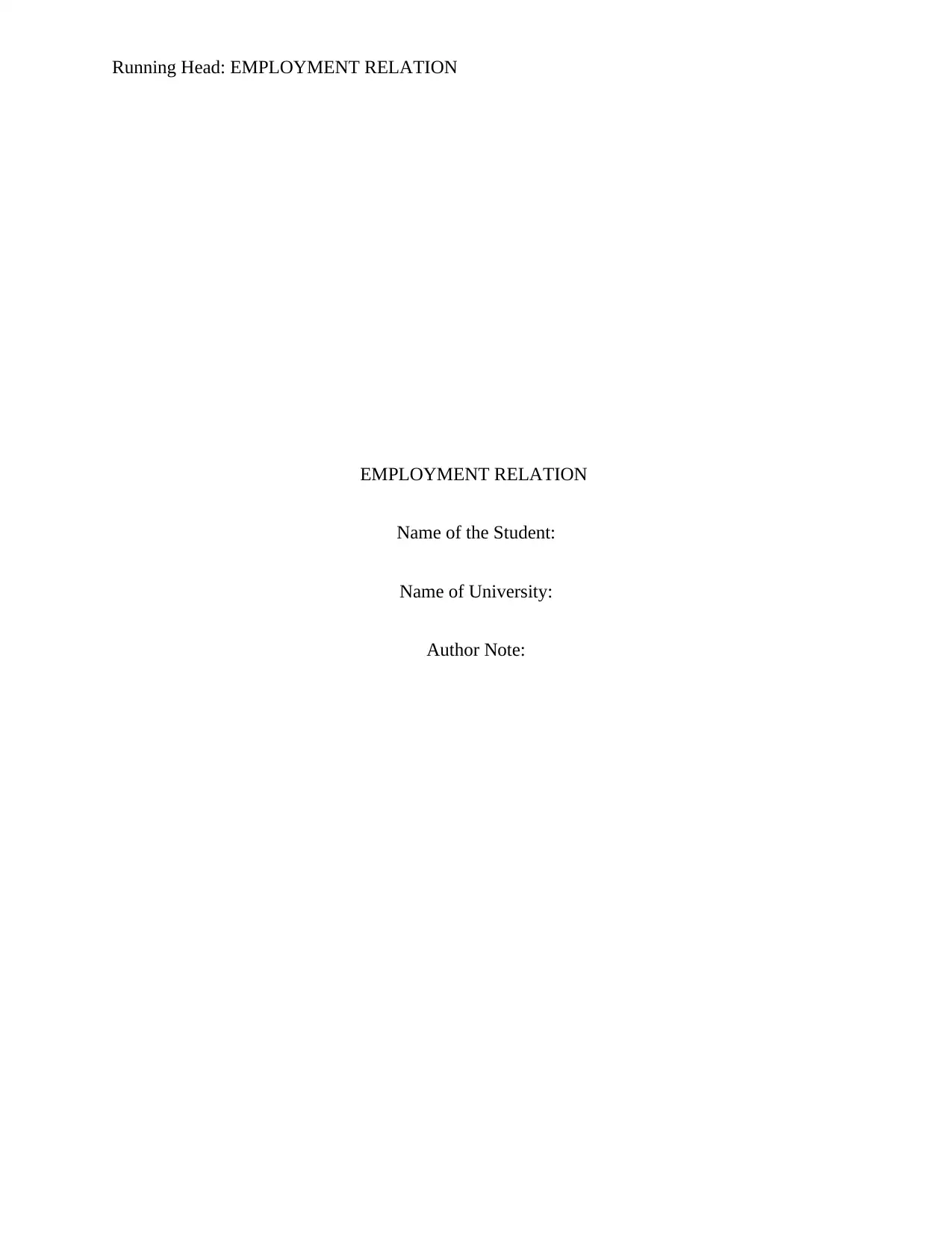
Running Head: EMPLOYMENT RELATION
EMPLOYMENT RELATION
Name of the Student:
Name of University:
Author Note:
EMPLOYMENT RELATION
Name of the Student:
Name of University:
Author Note:
Paraphrase This Document
Need a fresh take? Get an instant paraphrase of this document with our AI Paraphraser
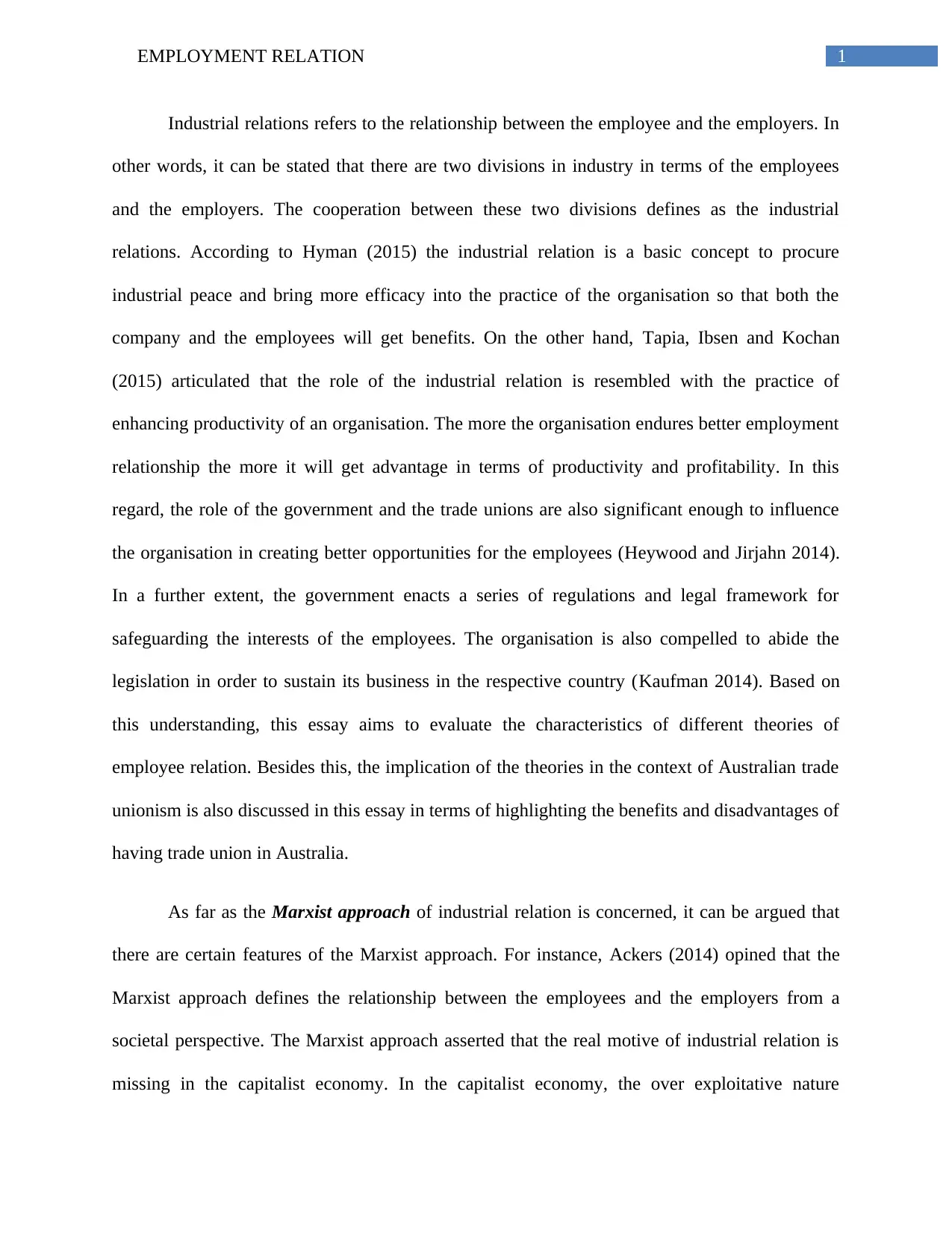
1EMPLOYMENT RELATION
Industrial relations refers to the relationship between the employee and the employers. In
other words, it can be stated that there are two divisions in industry in terms of the employees
and the employers. The cooperation between these two divisions defines as the industrial
relations. According to Hyman (2015) the industrial relation is a basic concept to procure
industrial peace and bring more efficacy into the practice of the organisation so that both the
company and the employees will get benefits. On the other hand, Tapia, Ibsen and Kochan
(2015) articulated that the role of the industrial relation is resembled with the practice of
enhancing productivity of an organisation. The more the organisation endures better employment
relationship the more it will get advantage in terms of productivity and profitability. In this
regard, the role of the government and the trade unions are also significant enough to influence
the organisation in creating better opportunities for the employees (Heywood and Jirjahn 2014).
In a further extent, the government enacts a series of regulations and legal framework for
safeguarding the interests of the employees. The organisation is also compelled to abide the
legislation in order to sustain its business in the respective country (Kaufman 2014). Based on
this understanding, this essay aims to evaluate the characteristics of different theories of
employee relation. Besides this, the implication of the theories in the context of Australian trade
unionism is also discussed in this essay in terms of highlighting the benefits and disadvantages of
having trade union in Australia.
As far as the Marxist approach of industrial relation is concerned, it can be argued that
there are certain features of the Marxist approach. For instance, Ackers (2014) opined that the
Marxist approach defines the relationship between the employees and the employers from a
societal perspective. The Marxist approach asserted that the real motive of industrial relation is
missing in the capitalist economy. In the capitalist economy, the over exploitative nature
Industrial relations refers to the relationship between the employee and the employers. In
other words, it can be stated that there are two divisions in industry in terms of the employees
and the employers. The cooperation between these two divisions defines as the industrial
relations. According to Hyman (2015) the industrial relation is a basic concept to procure
industrial peace and bring more efficacy into the practice of the organisation so that both the
company and the employees will get benefits. On the other hand, Tapia, Ibsen and Kochan
(2015) articulated that the role of the industrial relation is resembled with the practice of
enhancing productivity of an organisation. The more the organisation endures better employment
relationship the more it will get advantage in terms of productivity and profitability. In this
regard, the role of the government and the trade unions are also significant enough to influence
the organisation in creating better opportunities for the employees (Heywood and Jirjahn 2014).
In a further extent, the government enacts a series of regulations and legal framework for
safeguarding the interests of the employees. The organisation is also compelled to abide the
legislation in order to sustain its business in the respective country (Kaufman 2014). Based on
this understanding, this essay aims to evaluate the characteristics of different theories of
employee relation. Besides this, the implication of the theories in the context of Australian trade
unionism is also discussed in this essay in terms of highlighting the benefits and disadvantages of
having trade union in Australia.
As far as the Marxist approach of industrial relation is concerned, it can be argued that
there are certain features of the Marxist approach. For instance, Ackers (2014) opined that the
Marxist approach defines the relationship between the employees and the employers from a
societal perspective. The Marxist approach asserted that the real motive of industrial relation is
missing in the capitalist economy. In the capitalist economy, the over exploitative nature
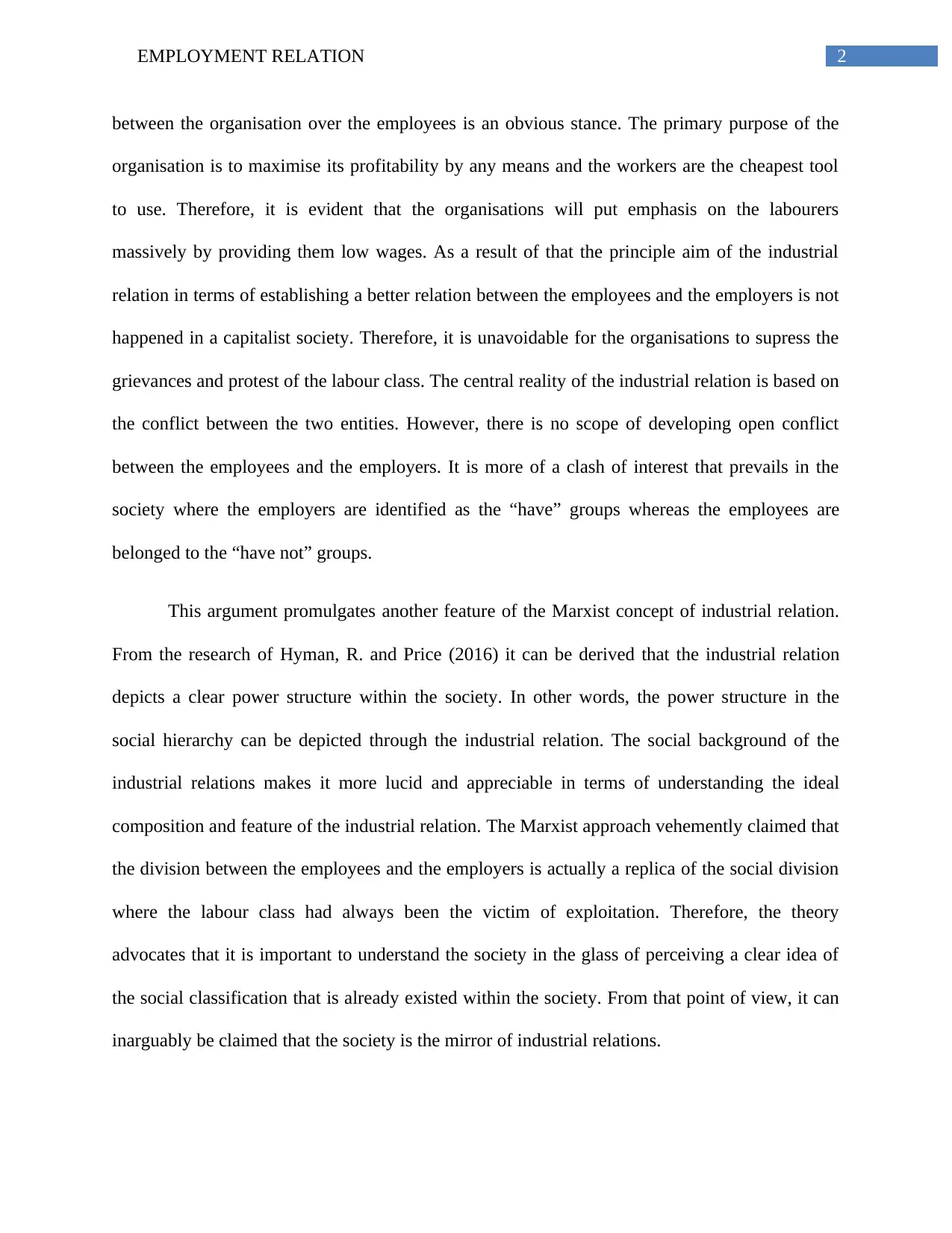
2EMPLOYMENT RELATION
between the organisation over the employees is an obvious stance. The primary purpose of the
organisation is to maximise its profitability by any means and the workers are the cheapest tool
to use. Therefore, it is evident that the organisations will put emphasis on the labourers
massively by providing them low wages. As a result of that the principle aim of the industrial
relation in terms of establishing a better relation between the employees and the employers is not
happened in a capitalist society. Therefore, it is unavoidable for the organisations to supress the
grievances and protest of the labour class. The central reality of the industrial relation is based on
the conflict between the two entities. However, there is no scope of developing open conflict
between the employees and the employers. It is more of a clash of interest that prevails in the
society where the employers are identified as the “have” groups whereas the employees are
belonged to the “have not” groups.
This argument promulgates another feature of the Marxist concept of industrial relation.
From the research of Hyman, R. and Price (2016) it can be derived that the industrial relation
depicts a clear power structure within the society. In other words, the power structure in the
social hierarchy can be depicted through the industrial relation. The social background of the
industrial relations makes it more lucid and appreciable in terms of understanding the ideal
composition and feature of the industrial relation. The Marxist approach vehemently claimed that
the division between the employees and the employers is actually a replica of the social division
where the labour class had always been the victim of exploitation. Therefore, the theory
advocates that it is important to understand the society in the glass of perceiving a clear idea of
the social classification that is already existed within the society. From that point of view, it can
inarguably be claimed that the society is the mirror of industrial relations.
between the organisation over the employees is an obvious stance. The primary purpose of the
organisation is to maximise its profitability by any means and the workers are the cheapest tool
to use. Therefore, it is evident that the organisations will put emphasis on the labourers
massively by providing them low wages. As a result of that the principle aim of the industrial
relation in terms of establishing a better relation between the employees and the employers is not
happened in a capitalist society. Therefore, it is unavoidable for the organisations to supress the
grievances and protest of the labour class. The central reality of the industrial relation is based on
the conflict between the two entities. However, there is no scope of developing open conflict
between the employees and the employers. It is more of a clash of interest that prevails in the
society where the employers are identified as the “have” groups whereas the employees are
belonged to the “have not” groups.
This argument promulgates another feature of the Marxist concept of industrial relation.
From the research of Hyman, R. and Price (2016) it can be derived that the industrial relation
depicts a clear power structure within the society. In other words, the power structure in the
social hierarchy can be depicted through the industrial relation. The social background of the
industrial relations makes it more lucid and appreciable in terms of understanding the ideal
composition and feature of the industrial relation. The Marxist approach vehemently claimed that
the division between the employees and the employers is actually a replica of the social division
where the labour class had always been the victim of exploitation. Therefore, the theory
advocates that it is important to understand the society in the glass of perceiving a clear idea of
the social classification that is already existed within the society. From that point of view, it can
inarguably be claimed that the society is the mirror of industrial relations.
⊘ This is a preview!⊘
Do you want full access?
Subscribe today to unlock all pages.

Trusted by 1+ million students worldwide
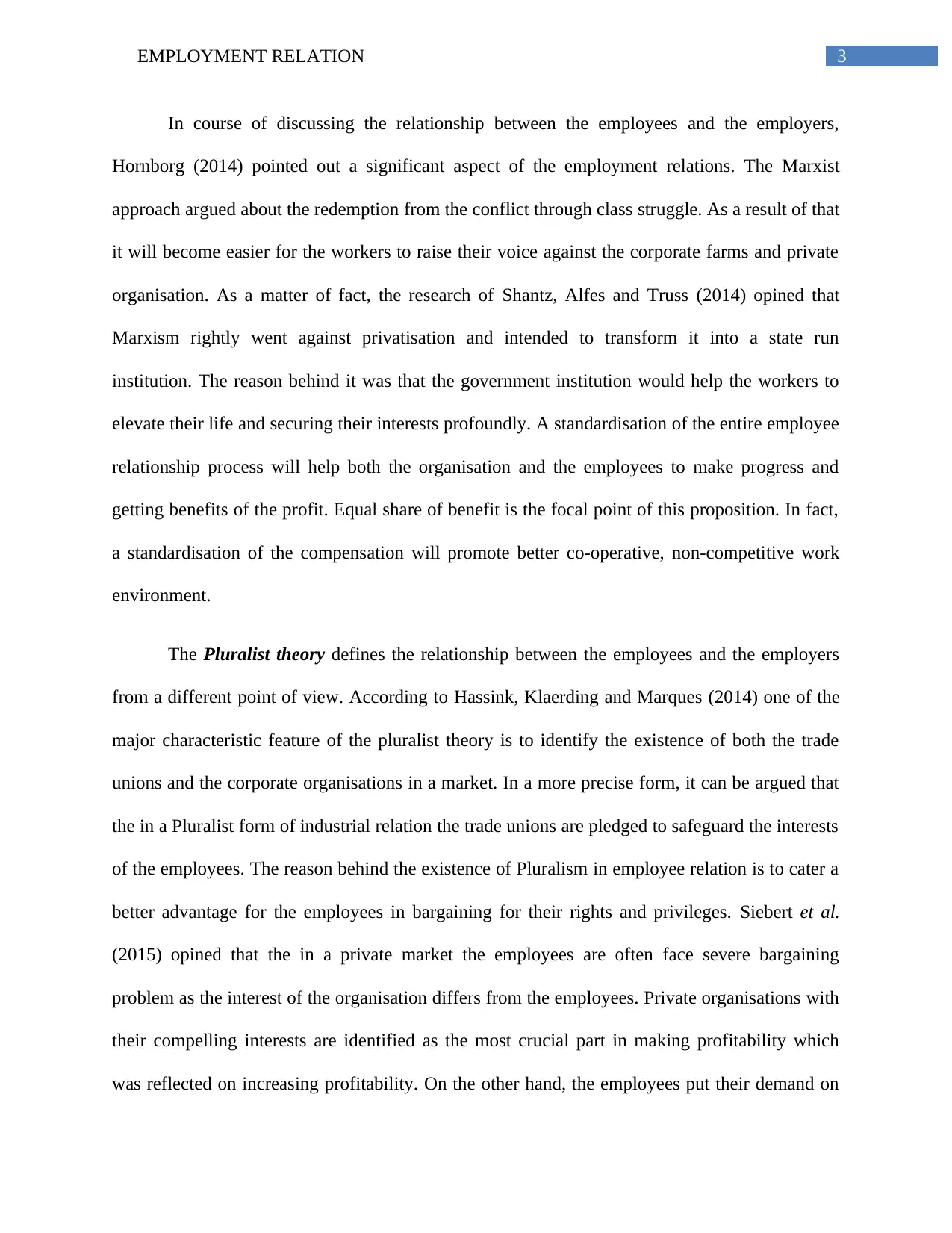
3EMPLOYMENT RELATION
In course of discussing the relationship between the employees and the employers,
Hornborg (2014) pointed out a significant aspect of the employment relations. The Marxist
approach argued about the redemption from the conflict through class struggle. As a result of that
it will become easier for the workers to raise their voice against the corporate farms and private
organisation. As a matter of fact, the research of Shantz, Alfes and Truss (2014) opined that
Marxism rightly went against privatisation and intended to transform it into a state run
institution. The reason behind it was that the government institution would help the workers to
elevate their life and securing their interests profoundly. A standardisation of the entire employee
relationship process will help both the organisation and the employees to make progress and
getting benefits of the profit. Equal share of benefit is the focal point of this proposition. In fact,
a standardisation of the compensation will promote better co-operative, non-competitive work
environment.
The Pluralist theory defines the relationship between the employees and the employers
from a different point of view. According to Hassink, Klaerding and Marques (2014) one of the
major characteristic feature of the pluralist theory is to identify the existence of both the trade
unions and the corporate organisations in a market. In a more precise form, it can be argued that
the in a Pluralist form of industrial relation the trade unions are pledged to safeguard the interests
of the employees. The reason behind the existence of Pluralism in employee relation is to cater a
better advantage for the employees in bargaining for their rights and privileges. Siebert et al.
(2015) opined that the in a private market the employees are often face severe bargaining
problem as the interest of the organisation differs from the employees. Private organisations with
their compelling interests are identified as the most crucial part in making profitability which
was reflected on increasing profitability. On the other hand, the employees put their demand on
In course of discussing the relationship between the employees and the employers,
Hornborg (2014) pointed out a significant aspect of the employment relations. The Marxist
approach argued about the redemption from the conflict through class struggle. As a result of that
it will become easier for the workers to raise their voice against the corporate farms and private
organisation. As a matter of fact, the research of Shantz, Alfes and Truss (2014) opined that
Marxism rightly went against privatisation and intended to transform it into a state run
institution. The reason behind it was that the government institution would help the workers to
elevate their life and securing their interests profoundly. A standardisation of the entire employee
relationship process will help both the organisation and the employees to make progress and
getting benefits of the profit. Equal share of benefit is the focal point of this proposition. In fact,
a standardisation of the compensation will promote better co-operative, non-competitive work
environment.
The Pluralist theory defines the relationship between the employees and the employers
from a different point of view. According to Hassink, Klaerding and Marques (2014) one of the
major characteristic feature of the pluralist theory is to identify the existence of both the trade
unions and the corporate organisations in a market. In a more precise form, it can be argued that
the in a Pluralist form of industrial relation the trade unions are pledged to safeguard the interests
of the employees. The reason behind the existence of Pluralism in employee relation is to cater a
better advantage for the employees in bargaining for their rights and privileges. Siebert et al.
(2015) opined that the in a private market the employees are often face severe bargaining
problem as the interest of the organisation differs from the employees. Private organisations with
their compelling interests are identified as the most crucial part in making profitability which
was reflected on increasing profitability. On the other hand, the employees put their demand on
Paraphrase This Document
Need a fresh take? Get an instant paraphrase of this document with our AI Paraphraser
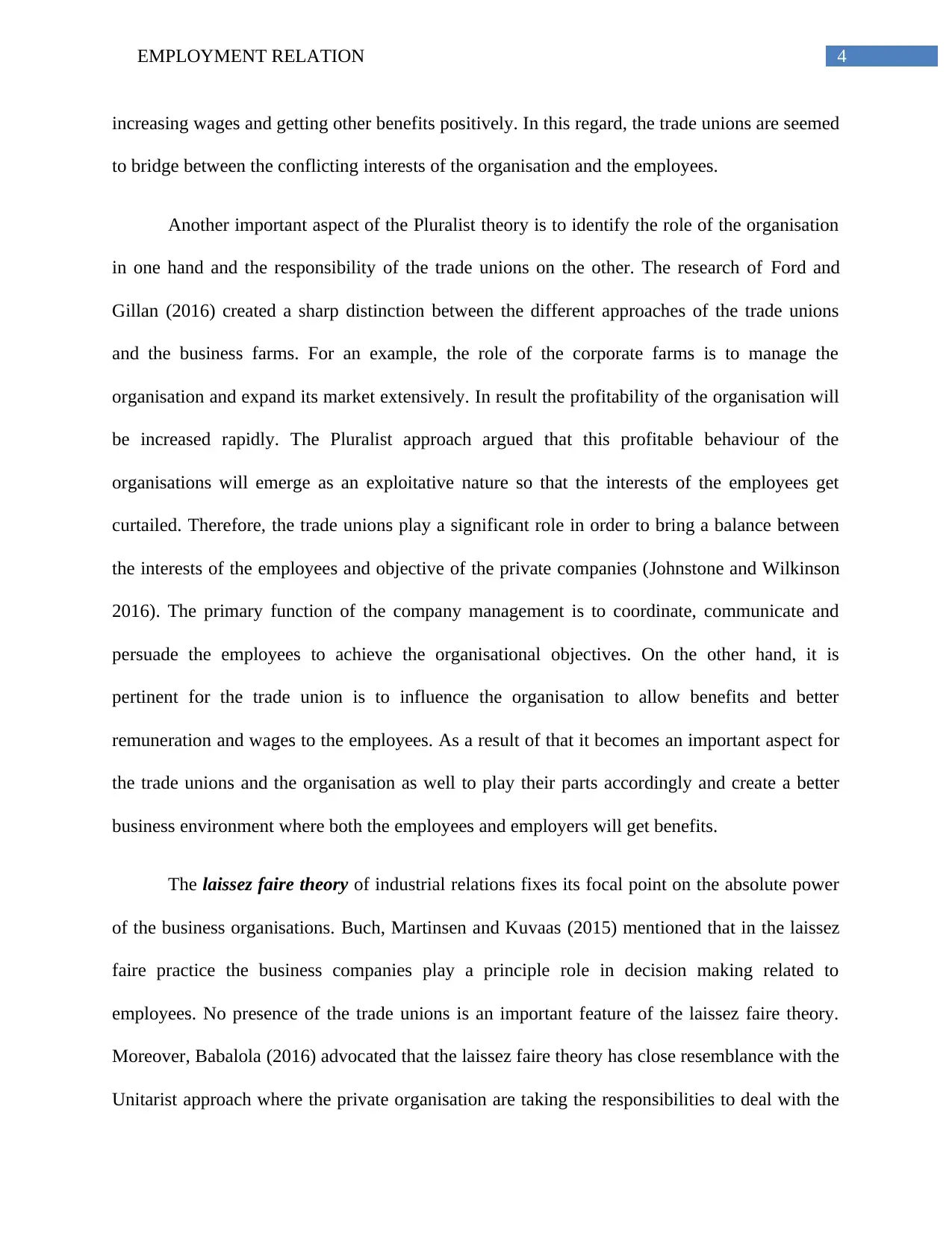
4EMPLOYMENT RELATION
increasing wages and getting other benefits positively. In this regard, the trade unions are seemed
to bridge between the conflicting interests of the organisation and the employees.
Another important aspect of the Pluralist theory is to identify the role of the organisation
in one hand and the responsibility of the trade unions on the other. The research of Ford and
Gillan (2016) created a sharp distinction between the different approaches of the trade unions
and the business farms. For an example, the role of the corporate farms is to manage the
organisation and expand its market extensively. In result the profitability of the organisation will
be increased rapidly. The Pluralist approach argued that this profitable behaviour of the
organisations will emerge as an exploitative nature so that the interests of the employees get
curtailed. Therefore, the trade unions play a significant role in order to bring a balance between
the interests of the employees and objective of the private companies (Johnstone and Wilkinson
2016). The primary function of the company management is to coordinate, communicate and
persuade the employees to achieve the organisational objectives. On the other hand, it is
pertinent for the trade union is to influence the organisation to allow benefits and better
remuneration and wages to the employees. As a result of that it becomes an important aspect for
the trade unions and the organisation as well to play their parts accordingly and create a better
business environment where both the employees and employers will get benefits.
The laissez faire theory of industrial relations fixes its focal point on the absolute power
of the business organisations. Buch, Martinsen and Kuvaas (2015) mentioned that in the laissez
faire practice the business companies play a principle role in decision making related to
employees. No presence of the trade unions is an important feature of the laissez faire theory.
Moreover, Babalola (2016) advocated that the laissez faire theory has close resemblance with the
Unitarist approach where the private organisation are taking the responsibilities to deal with the
increasing wages and getting other benefits positively. In this regard, the trade unions are seemed
to bridge between the conflicting interests of the organisation and the employees.
Another important aspect of the Pluralist theory is to identify the role of the organisation
in one hand and the responsibility of the trade unions on the other. The research of Ford and
Gillan (2016) created a sharp distinction between the different approaches of the trade unions
and the business farms. For an example, the role of the corporate farms is to manage the
organisation and expand its market extensively. In result the profitability of the organisation will
be increased rapidly. The Pluralist approach argued that this profitable behaviour of the
organisations will emerge as an exploitative nature so that the interests of the employees get
curtailed. Therefore, the trade unions play a significant role in order to bring a balance between
the interests of the employees and objective of the private companies (Johnstone and Wilkinson
2016). The primary function of the company management is to coordinate, communicate and
persuade the employees to achieve the organisational objectives. On the other hand, it is
pertinent for the trade union is to influence the organisation to allow benefits and better
remuneration and wages to the employees. As a result of that it becomes an important aspect for
the trade unions and the organisation as well to play their parts accordingly and create a better
business environment where both the employees and employers will get benefits.
The laissez faire theory of industrial relations fixes its focal point on the absolute power
of the business organisations. Buch, Martinsen and Kuvaas (2015) mentioned that in the laissez
faire practice the business companies play a principle role in decision making related to
employees. No presence of the trade unions is an important feature of the laissez faire theory.
Moreover, Babalola (2016) advocated that the laissez faire theory has close resemblance with the
Unitarist approach where the private organisation are taking the responsibilities to deal with the
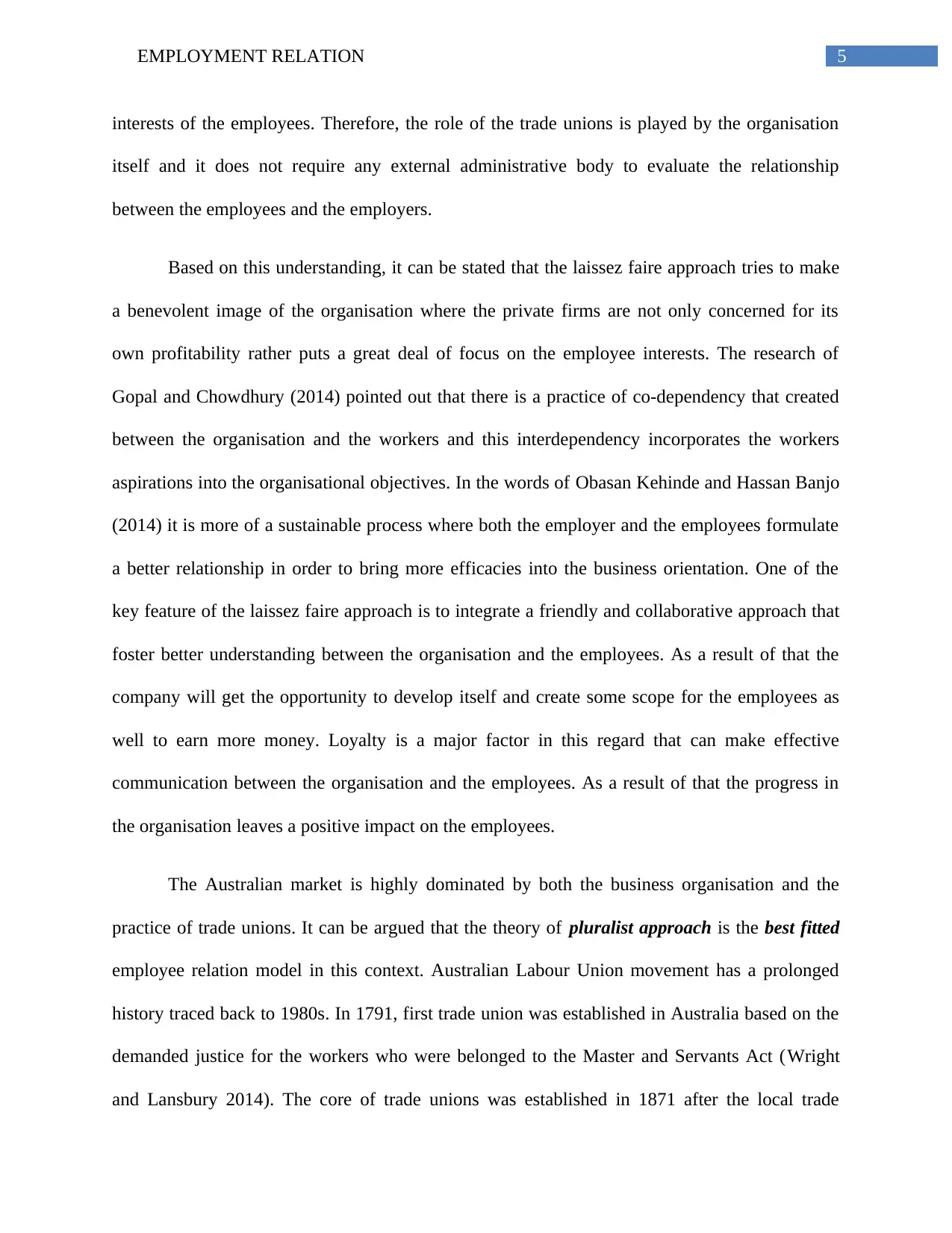
5EMPLOYMENT RELATION
interests of the employees. Therefore, the role of the trade unions is played by the organisation
itself and it does not require any external administrative body to evaluate the relationship
between the employees and the employers.
Based on this understanding, it can be stated that the laissez faire approach tries to make
a benevolent image of the organisation where the private firms are not only concerned for its
own profitability rather puts a great deal of focus on the employee interests. The research of
Gopal and Chowdhury (2014) pointed out that there is a practice of co-dependency that created
between the organisation and the workers and this interdependency incorporates the workers
aspirations into the organisational objectives. In the words of Obasan Kehinde and Hassan Banjo
(2014) it is more of a sustainable process where both the employer and the employees formulate
a better relationship in order to bring more efficacies into the business orientation. One of the
key feature of the laissez faire approach is to integrate a friendly and collaborative approach that
foster better understanding between the organisation and the employees. As a result of that the
company will get the opportunity to develop itself and create some scope for the employees as
well to earn more money. Loyalty is a major factor in this regard that can make effective
communication between the organisation and the employees. As a result of that the progress in
the organisation leaves a positive impact on the employees.
The Australian market is highly dominated by both the business organisation and the
practice of trade unions. It can be argued that the theory of pluralist approach is the best fitted
employee relation model in this context. Australian Labour Union movement has a prolonged
history traced back to 1980s. In 1791, first trade union was established in Australia based on the
demanded justice for the workers who were belonged to the Master and Servants Act (Wright
and Lansbury 2014). The core of trade unions was established in 1871 after the local trade
interests of the employees. Therefore, the role of the trade unions is played by the organisation
itself and it does not require any external administrative body to evaluate the relationship
between the employees and the employers.
Based on this understanding, it can be stated that the laissez faire approach tries to make
a benevolent image of the organisation where the private firms are not only concerned for its
own profitability rather puts a great deal of focus on the employee interests. The research of
Gopal and Chowdhury (2014) pointed out that there is a practice of co-dependency that created
between the organisation and the workers and this interdependency incorporates the workers
aspirations into the organisational objectives. In the words of Obasan Kehinde and Hassan Banjo
(2014) it is more of a sustainable process where both the employer and the employees formulate
a better relationship in order to bring more efficacies into the business orientation. One of the
key feature of the laissez faire approach is to integrate a friendly and collaborative approach that
foster better understanding between the organisation and the employees. As a result of that the
company will get the opportunity to develop itself and create some scope for the employees as
well to earn more money. Loyalty is a major factor in this regard that can make effective
communication between the organisation and the employees. As a result of that the progress in
the organisation leaves a positive impact on the employees.
The Australian market is highly dominated by both the business organisation and the
practice of trade unions. It can be argued that the theory of pluralist approach is the best fitted
employee relation model in this context. Australian Labour Union movement has a prolonged
history traced back to 1980s. In 1791, first trade union was established in Australia based on the
demanded justice for the workers who were belonged to the Master and Servants Act (Wright
and Lansbury 2014). The core of trade unions was established in 1871 after the local trade
⊘ This is a preview!⊘
Do you want full access?
Subscribe today to unlock all pages.

Trusted by 1+ million students worldwide
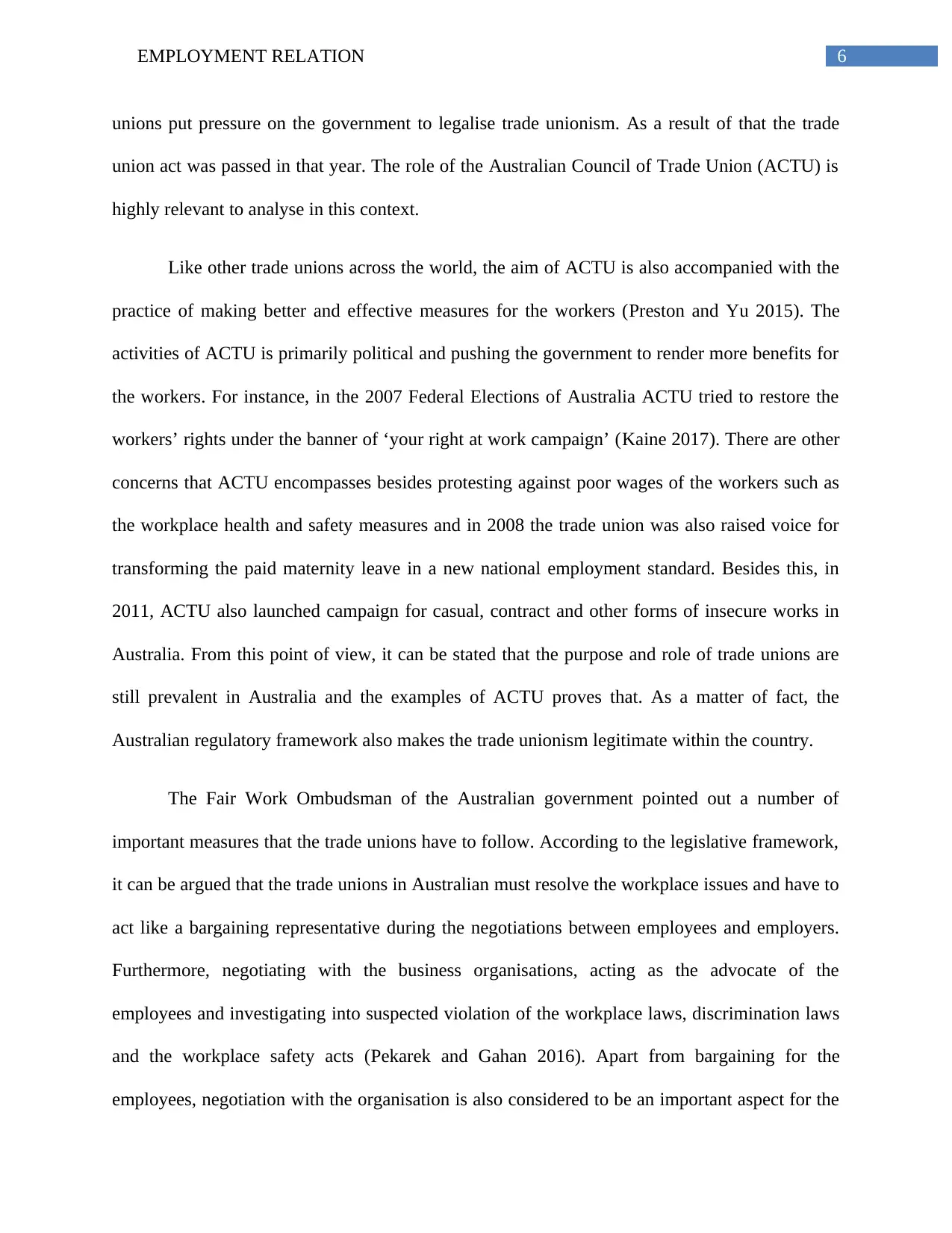
6EMPLOYMENT RELATION
unions put pressure on the government to legalise trade unionism. As a result of that the trade
union act was passed in that year. The role of the Australian Council of Trade Union (ACTU) is
highly relevant to analyse in this context.
Like other trade unions across the world, the aim of ACTU is also accompanied with the
practice of making better and effective measures for the workers (Preston and Yu 2015). The
activities of ACTU is primarily political and pushing the government to render more benefits for
the workers. For instance, in the 2007 Federal Elections of Australia ACTU tried to restore the
workers’ rights under the banner of ‘your right at work campaign’ (Kaine 2017). There are other
concerns that ACTU encompasses besides protesting against poor wages of the workers such as
the workplace health and safety measures and in 2008 the trade union was also raised voice for
transforming the paid maternity leave in a new national employment standard. Besides this, in
2011, ACTU also launched campaign for casual, contract and other forms of insecure works in
Australia. From this point of view, it can be stated that the purpose and role of trade unions are
still prevalent in Australia and the examples of ACTU proves that. As a matter of fact, the
Australian regulatory framework also makes the trade unionism legitimate within the country.
The Fair Work Ombudsman of the Australian government pointed out a number of
important measures that the trade unions have to follow. According to the legislative framework,
it can be argued that the trade unions in Australian must resolve the workplace issues and have to
act like a bargaining representative during the negotiations between employees and employers.
Furthermore, negotiating with the business organisations, acting as the advocate of the
employees and investigating into suspected violation of the workplace laws, discrimination laws
and the workplace safety acts (Pekarek and Gahan 2016). Apart from bargaining for the
employees, negotiation with the organisation is also considered to be an important aspect for the
unions put pressure on the government to legalise trade unionism. As a result of that the trade
union act was passed in that year. The role of the Australian Council of Trade Union (ACTU) is
highly relevant to analyse in this context.
Like other trade unions across the world, the aim of ACTU is also accompanied with the
practice of making better and effective measures for the workers (Preston and Yu 2015). The
activities of ACTU is primarily political and pushing the government to render more benefits for
the workers. For instance, in the 2007 Federal Elections of Australia ACTU tried to restore the
workers’ rights under the banner of ‘your right at work campaign’ (Kaine 2017). There are other
concerns that ACTU encompasses besides protesting against poor wages of the workers such as
the workplace health and safety measures and in 2008 the trade union was also raised voice for
transforming the paid maternity leave in a new national employment standard. Besides this, in
2011, ACTU also launched campaign for casual, contract and other forms of insecure works in
Australia. From this point of view, it can be stated that the purpose and role of trade unions are
still prevalent in Australia and the examples of ACTU proves that. As a matter of fact, the
Australian regulatory framework also makes the trade unionism legitimate within the country.
The Fair Work Ombudsman of the Australian government pointed out a number of
important measures that the trade unions have to follow. According to the legislative framework,
it can be argued that the trade unions in Australian must resolve the workplace issues and have to
act like a bargaining representative during the negotiations between employees and employers.
Furthermore, negotiating with the business organisations, acting as the advocate of the
employees and investigating into suspected violation of the workplace laws, discrimination laws
and the workplace safety acts (Pekarek and Gahan 2016). Apart from bargaining for the
employees, negotiation with the organisation is also considered to be an important aspect for the
Paraphrase This Document
Need a fresh take? Get an instant paraphrase of this document with our AI Paraphraser
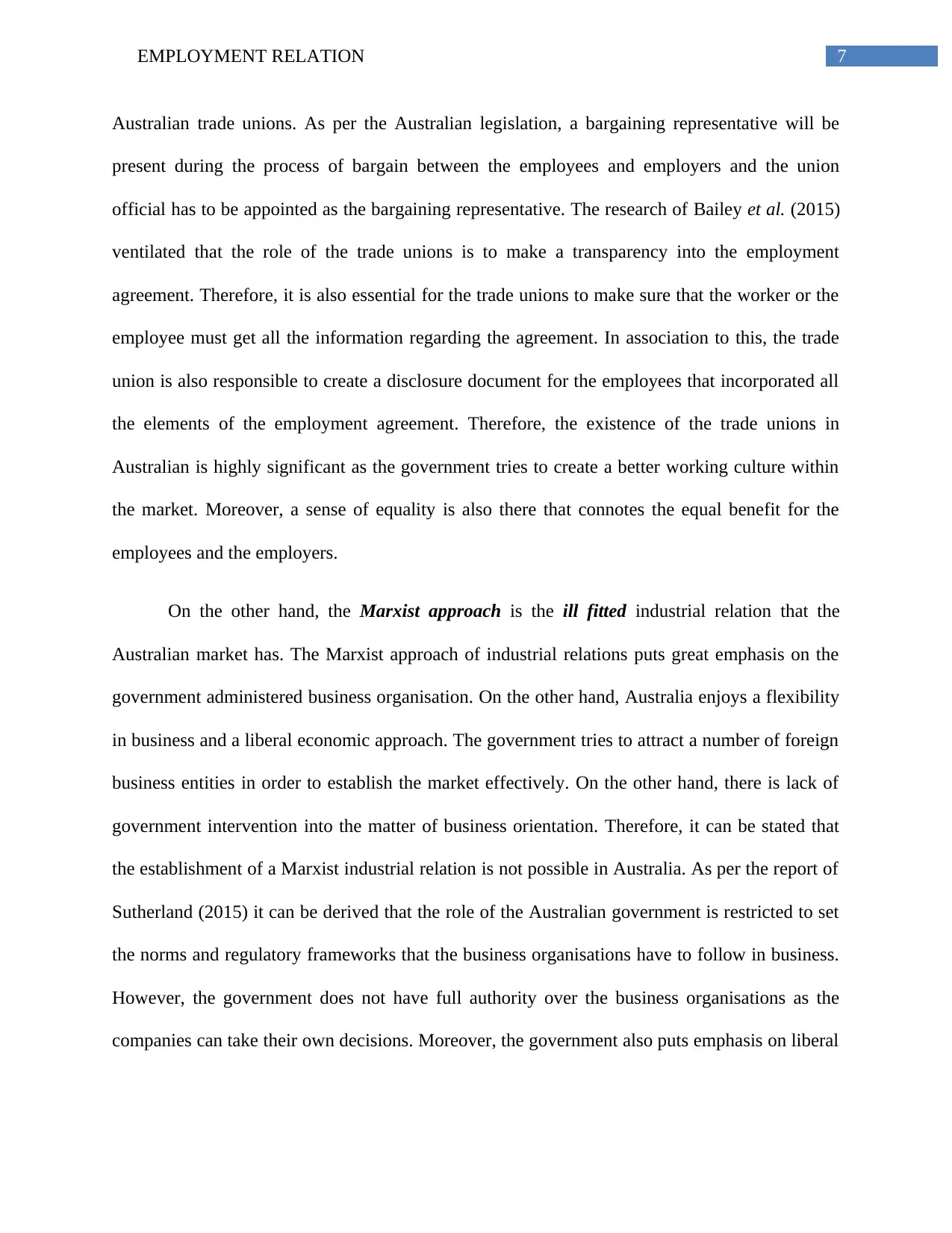
7EMPLOYMENT RELATION
Australian trade unions. As per the Australian legislation, a bargaining representative will be
present during the process of bargain between the employees and employers and the union
official has to be appointed as the bargaining representative. The research of Bailey et al. (2015)
ventilated that the role of the trade unions is to make a transparency into the employment
agreement. Therefore, it is also essential for the trade unions to make sure that the worker or the
employee must get all the information regarding the agreement. In association to this, the trade
union is also responsible to create a disclosure document for the employees that incorporated all
the elements of the employment agreement. Therefore, the existence of the trade unions in
Australian is highly significant as the government tries to create a better working culture within
the market. Moreover, a sense of equality is also there that connotes the equal benefit for the
employees and the employers.
On the other hand, the Marxist approach is the ill fitted industrial relation that the
Australian market has. The Marxist approach of industrial relations puts great emphasis on the
government administered business organisation. On the other hand, Australia enjoys a flexibility
in business and a liberal economic approach. The government tries to attract a number of foreign
business entities in order to establish the market effectively. On the other hand, there is lack of
government intervention into the matter of business orientation. Therefore, it can be stated that
the establishment of a Marxist industrial relation is not possible in Australia. As per the report of
Sutherland (2015) it can be derived that the role of the Australian government is restricted to set
the norms and regulatory frameworks that the business organisations have to follow in business.
However, the government does not have full authority over the business organisations as the
companies can take their own decisions. Moreover, the government also puts emphasis on liberal
Australian trade unions. As per the Australian legislation, a bargaining representative will be
present during the process of bargain between the employees and employers and the union
official has to be appointed as the bargaining representative. The research of Bailey et al. (2015)
ventilated that the role of the trade unions is to make a transparency into the employment
agreement. Therefore, it is also essential for the trade unions to make sure that the worker or the
employee must get all the information regarding the agreement. In association to this, the trade
union is also responsible to create a disclosure document for the employees that incorporated all
the elements of the employment agreement. Therefore, the existence of the trade unions in
Australian is highly significant as the government tries to create a better working culture within
the market. Moreover, a sense of equality is also there that connotes the equal benefit for the
employees and the employers.
On the other hand, the Marxist approach is the ill fitted industrial relation that the
Australian market has. The Marxist approach of industrial relations puts great emphasis on the
government administered business organisation. On the other hand, Australia enjoys a flexibility
in business and a liberal economic approach. The government tries to attract a number of foreign
business entities in order to establish the market effectively. On the other hand, there is lack of
government intervention into the matter of business orientation. Therefore, it can be stated that
the establishment of a Marxist industrial relation is not possible in Australia. As per the report of
Sutherland (2015) it can be derived that the role of the Australian government is restricted to set
the norms and regulatory frameworks that the business organisations have to follow in business.
However, the government does not have full authority over the business organisations as the
companies can take their own decisions. Moreover, the government also puts emphasis on liberal
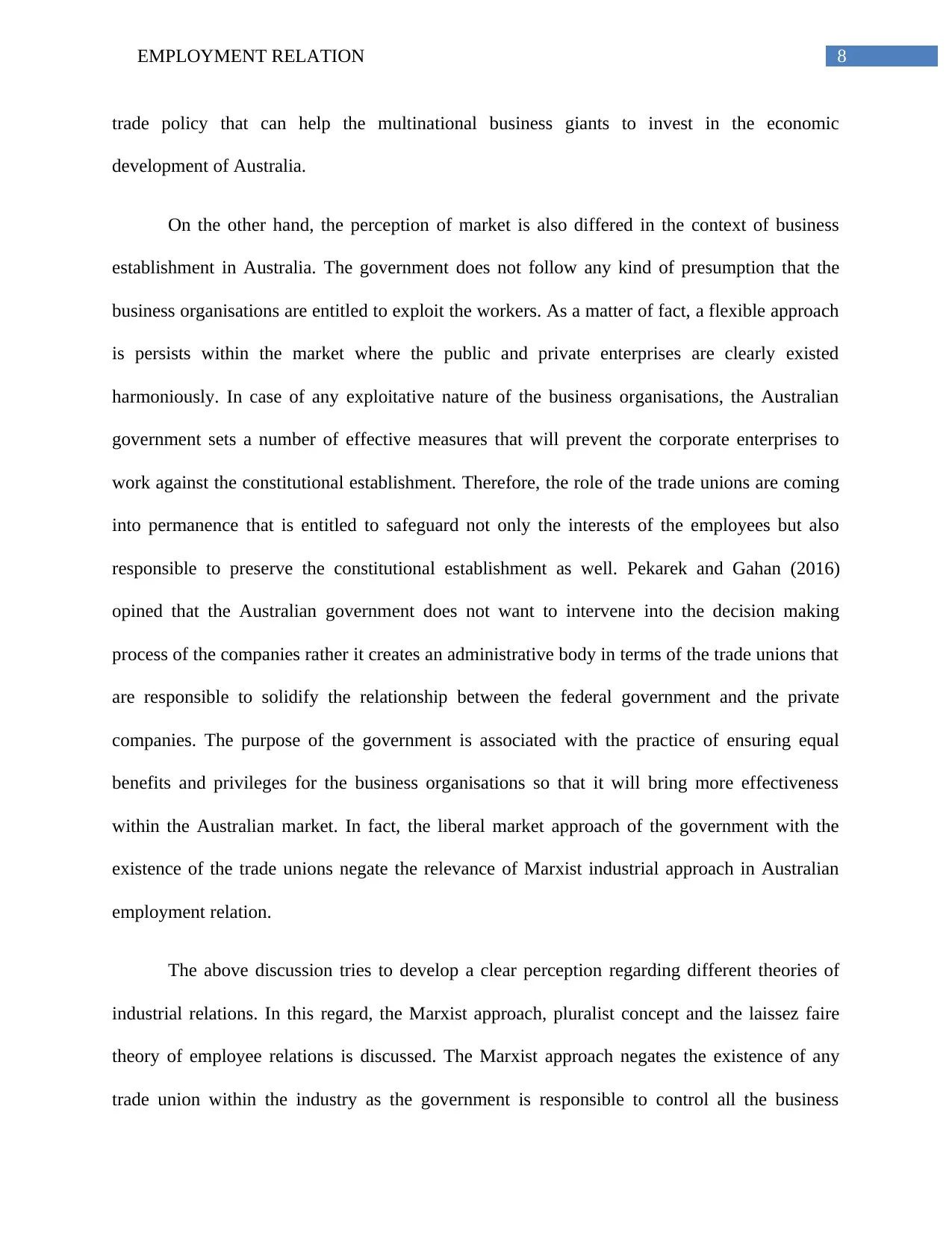
8EMPLOYMENT RELATION
trade policy that can help the multinational business giants to invest in the economic
development of Australia.
On the other hand, the perception of market is also differed in the context of business
establishment in Australia. The government does not follow any kind of presumption that the
business organisations are entitled to exploit the workers. As a matter of fact, a flexible approach
is persists within the market where the public and private enterprises are clearly existed
harmoniously. In case of any exploitative nature of the business organisations, the Australian
government sets a number of effective measures that will prevent the corporate enterprises to
work against the constitutional establishment. Therefore, the role of the trade unions are coming
into permanence that is entitled to safeguard not only the interests of the employees but also
responsible to preserve the constitutional establishment as well. Pekarek and Gahan (2016)
opined that the Australian government does not want to intervene into the decision making
process of the companies rather it creates an administrative body in terms of the trade unions that
are responsible to solidify the relationship between the federal government and the private
companies. The purpose of the government is associated with the practice of ensuring equal
benefits and privileges for the business organisations so that it will bring more effectiveness
within the Australian market. In fact, the liberal market approach of the government with the
existence of the trade unions negate the relevance of Marxist industrial approach in Australian
employment relation.
The above discussion tries to develop a clear perception regarding different theories of
industrial relations. In this regard, the Marxist approach, pluralist concept and the laissez faire
theory of employee relations is discussed. The Marxist approach negates the existence of any
trade union within the industry as the government is responsible to control all the business
trade policy that can help the multinational business giants to invest in the economic
development of Australia.
On the other hand, the perception of market is also differed in the context of business
establishment in Australia. The government does not follow any kind of presumption that the
business organisations are entitled to exploit the workers. As a matter of fact, a flexible approach
is persists within the market where the public and private enterprises are clearly existed
harmoniously. In case of any exploitative nature of the business organisations, the Australian
government sets a number of effective measures that will prevent the corporate enterprises to
work against the constitutional establishment. Therefore, the role of the trade unions are coming
into permanence that is entitled to safeguard not only the interests of the employees but also
responsible to preserve the constitutional establishment as well. Pekarek and Gahan (2016)
opined that the Australian government does not want to intervene into the decision making
process of the companies rather it creates an administrative body in terms of the trade unions that
are responsible to solidify the relationship between the federal government and the private
companies. The purpose of the government is associated with the practice of ensuring equal
benefits and privileges for the business organisations so that it will bring more effectiveness
within the Australian market. In fact, the liberal market approach of the government with the
existence of the trade unions negate the relevance of Marxist industrial approach in Australian
employment relation.
The above discussion tries to develop a clear perception regarding different theories of
industrial relations. In this regard, the Marxist approach, pluralist concept and the laissez faire
theory of employee relations is discussed. The Marxist approach negates the existence of any
trade union within the industry as the government is responsible to control all the business
⊘ This is a preview!⊘
Do you want full access?
Subscribe today to unlock all pages.

Trusted by 1+ million students worldwide
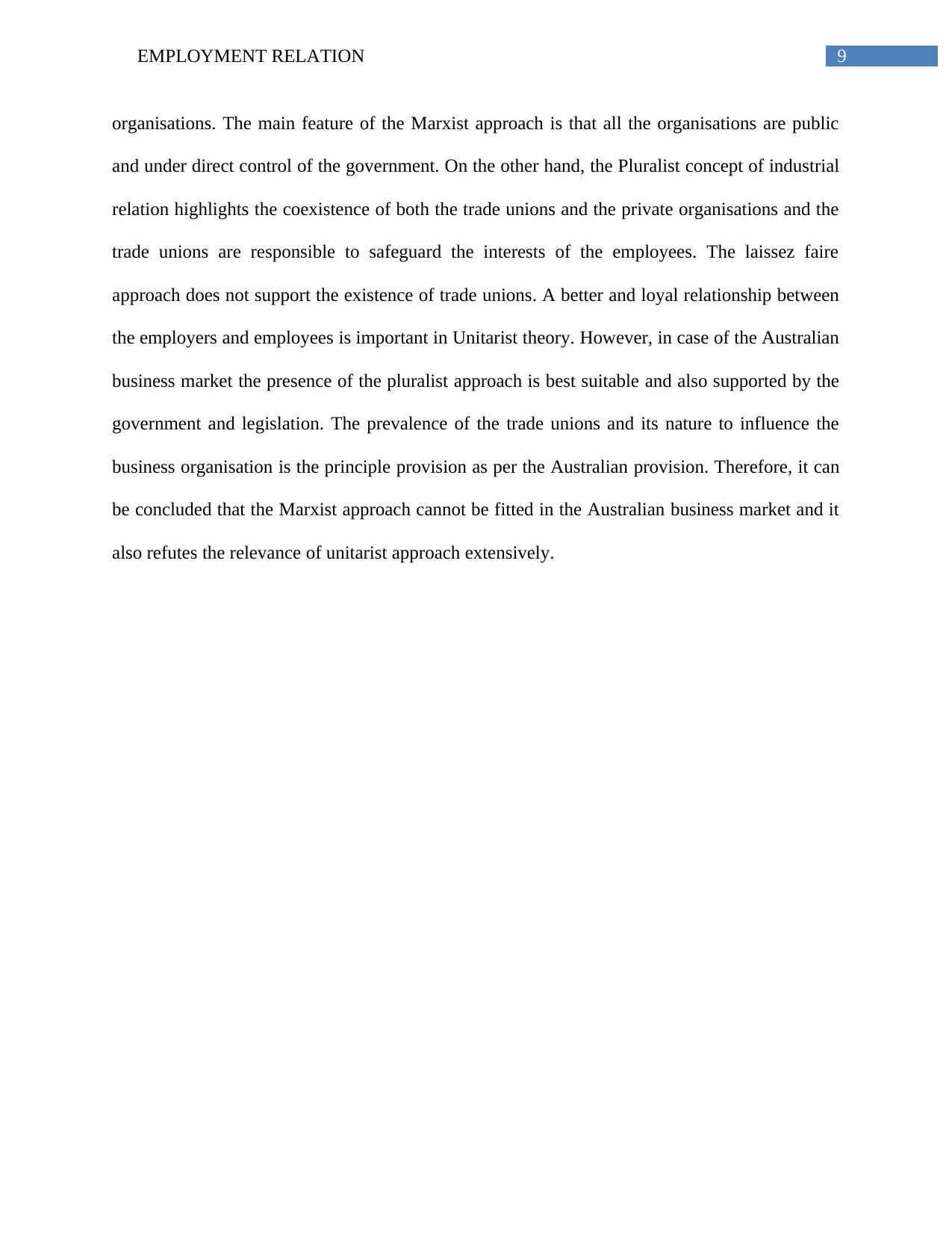
9EMPLOYMENT RELATION
organisations. The main feature of the Marxist approach is that all the organisations are public
and under direct control of the government. On the other hand, the Pluralist concept of industrial
relation highlights the coexistence of both the trade unions and the private organisations and the
trade unions are responsible to safeguard the interests of the employees. The laissez faire
approach does not support the existence of trade unions. A better and loyal relationship between
the employers and employees is important in Unitarist theory. However, in case of the Australian
business market the presence of the pluralist approach is best suitable and also supported by the
government and legislation. The prevalence of the trade unions and its nature to influence the
business organisation is the principle provision as per the Australian provision. Therefore, it can
be concluded that the Marxist approach cannot be fitted in the Australian business market and it
also refutes the relevance of unitarist approach extensively.
organisations. The main feature of the Marxist approach is that all the organisations are public
and under direct control of the government. On the other hand, the Pluralist concept of industrial
relation highlights the coexistence of both the trade unions and the private organisations and the
trade unions are responsible to safeguard the interests of the employees. The laissez faire
approach does not support the existence of trade unions. A better and loyal relationship between
the employers and employees is important in Unitarist theory. However, in case of the Australian
business market the presence of the pluralist approach is best suitable and also supported by the
government and legislation. The prevalence of the trade unions and its nature to influence the
business organisation is the principle provision as per the Australian provision. Therefore, it can
be concluded that the Marxist approach cannot be fitted in the Australian business market and it
also refutes the relevance of unitarist approach extensively.
Paraphrase This Document
Need a fresh take? Get an instant paraphrase of this document with our AI Paraphraser
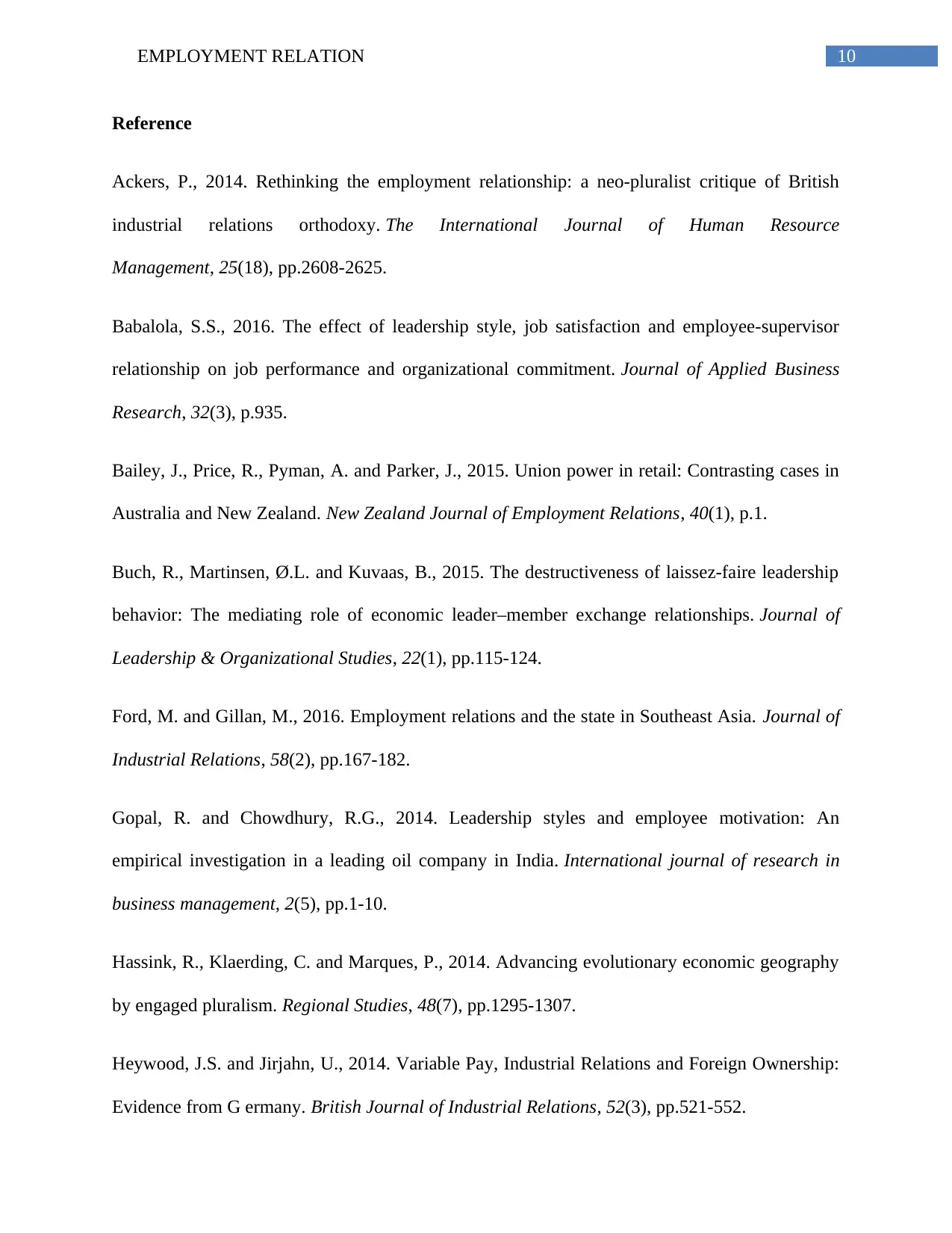
10EMPLOYMENT RELATION
Reference
Ackers, P., 2014. Rethinking the employment relationship: a neo-pluralist critique of British
industrial relations orthodoxy. The International Journal of Human Resource
Management, 25(18), pp.2608-2625.
Babalola, S.S., 2016. The effect of leadership style, job satisfaction and employee-supervisor
relationship on job performance and organizational commitment. Journal of Applied Business
Research, 32(3), p.935.
Bailey, J., Price, R., Pyman, A. and Parker, J., 2015. Union power in retail: Contrasting cases in
Australia and New Zealand. New Zealand Journal of Employment Relations, 40(1), p.1.
Buch, R., Martinsen, Ø.L. and Kuvaas, B., 2015. The destructiveness of laissez-faire leadership
behavior: The mediating role of economic leader–member exchange relationships. Journal of
Leadership & Organizational Studies, 22(1), pp.115-124.
Ford, M. and Gillan, M., 2016. Employment relations and the state in Southeast Asia. Journal of
Industrial Relations, 58(2), pp.167-182.
Gopal, R. and Chowdhury, R.G., 2014. Leadership styles and employee motivation: An
empirical investigation in a leading oil company in India. International journal of research in
business management, 2(5), pp.1-10.
Hassink, R., Klaerding, C. and Marques, P., 2014. Advancing evolutionary economic geography
by engaged pluralism. Regional Studies, 48(7), pp.1295-1307.
Heywood, J.S. and Jirjahn, U., 2014. Variable Pay, Industrial Relations and Foreign Ownership:
Evidence from G ermany. British Journal of Industrial Relations, 52(3), pp.521-552.
Reference
Ackers, P., 2014. Rethinking the employment relationship: a neo-pluralist critique of British
industrial relations orthodoxy. The International Journal of Human Resource
Management, 25(18), pp.2608-2625.
Babalola, S.S., 2016. The effect of leadership style, job satisfaction and employee-supervisor
relationship on job performance and organizational commitment. Journal of Applied Business
Research, 32(3), p.935.
Bailey, J., Price, R., Pyman, A. and Parker, J., 2015. Union power in retail: Contrasting cases in
Australia and New Zealand. New Zealand Journal of Employment Relations, 40(1), p.1.
Buch, R., Martinsen, Ø.L. and Kuvaas, B., 2015. The destructiveness of laissez-faire leadership
behavior: The mediating role of economic leader–member exchange relationships. Journal of
Leadership & Organizational Studies, 22(1), pp.115-124.
Ford, M. and Gillan, M., 2016. Employment relations and the state in Southeast Asia. Journal of
Industrial Relations, 58(2), pp.167-182.
Gopal, R. and Chowdhury, R.G., 2014. Leadership styles and employee motivation: An
empirical investigation in a leading oil company in India. International journal of research in
business management, 2(5), pp.1-10.
Hassink, R., Klaerding, C. and Marques, P., 2014. Advancing evolutionary economic geography
by engaged pluralism. Regional Studies, 48(7), pp.1295-1307.
Heywood, J.S. and Jirjahn, U., 2014. Variable Pay, Industrial Relations and Foreign Ownership:
Evidence from G ermany. British Journal of Industrial Relations, 52(3), pp.521-552.
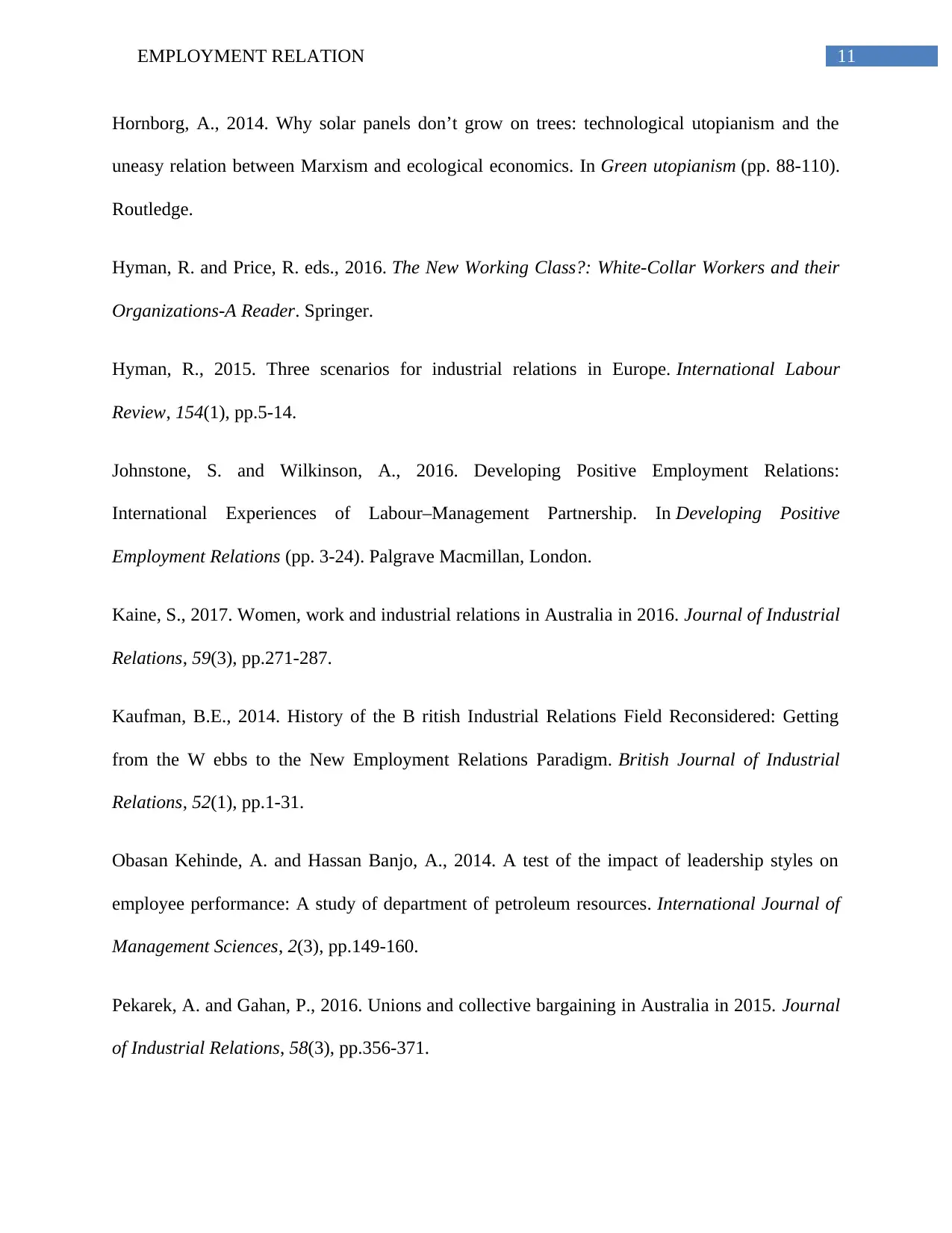
11EMPLOYMENT RELATION
Hornborg, A., 2014. Why solar panels don’t grow on trees: technological utopianism and the
uneasy relation between Marxism and ecological economics. In Green utopianism (pp. 88-110).
Routledge.
Hyman, R. and Price, R. eds., 2016. The New Working Class?: White-Collar Workers and their
Organizations-A Reader. Springer.
Hyman, R., 2015. Three scenarios for industrial relations in Europe. International Labour
Review, 154(1), pp.5-14.
Johnstone, S. and Wilkinson, A., 2016. Developing Positive Employment Relations:
International Experiences of Labour–Management Partnership. In Developing Positive
Employment Relations (pp. 3-24). Palgrave Macmillan, London.
Kaine, S., 2017. Women, work and industrial relations in Australia in 2016. Journal of Industrial
Relations, 59(3), pp.271-287.
Kaufman, B.E., 2014. History of the B ritish Industrial Relations Field Reconsidered: Getting
from the W ebbs to the New Employment Relations Paradigm. British Journal of Industrial
Relations, 52(1), pp.1-31.
Obasan Kehinde, A. and Hassan Banjo, A., 2014. A test of the impact of leadership styles on
employee performance: A study of department of petroleum resources. International Journal of
Management Sciences, 2(3), pp.149-160.
Pekarek, A. and Gahan, P., 2016. Unions and collective bargaining in Australia in 2015. Journal
of Industrial Relations, 58(3), pp.356-371.
Hornborg, A., 2014. Why solar panels don’t grow on trees: technological utopianism and the
uneasy relation between Marxism and ecological economics. In Green utopianism (pp. 88-110).
Routledge.
Hyman, R. and Price, R. eds., 2016. The New Working Class?: White-Collar Workers and their
Organizations-A Reader. Springer.
Hyman, R., 2015. Three scenarios for industrial relations in Europe. International Labour
Review, 154(1), pp.5-14.
Johnstone, S. and Wilkinson, A., 2016. Developing Positive Employment Relations:
International Experiences of Labour–Management Partnership. In Developing Positive
Employment Relations (pp. 3-24). Palgrave Macmillan, London.
Kaine, S., 2017. Women, work and industrial relations in Australia in 2016. Journal of Industrial
Relations, 59(3), pp.271-287.
Kaufman, B.E., 2014. History of the B ritish Industrial Relations Field Reconsidered: Getting
from the W ebbs to the New Employment Relations Paradigm. British Journal of Industrial
Relations, 52(1), pp.1-31.
Obasan Kehinde, A. and Hassan Banjo, A., 2014. A test of the impact of leadership styles on
employee performance: A study of department of petroleum resources. International Journal of
Management Sciences, 2(3), pp.149-160.
Pekarek, A. and Gahan, P., 2016. Unions and collective bargaining in Australia in 2015. Journal
of Industrial Relations, 58(3), pp.356-371.
⊘ This is a preview!⊘
Do you want full access?
Subscribe today to unlock all pages.

Trusted by 1+ million students worldwide
1 out of 13
Related Documents
Your All-in-One AI-Powered Toolkit for Academic Success.
+13062052269
info@desklib.com
Available 24*7 on WhatsApp / Email
![[object Object]](/_next/static/media/star-bottom.7253800d.svg)
Unlock your academic potential
Copyright © 2020–2025 A2Z Services. All Rights Reserved. Developed and managed by ZUCOL.





